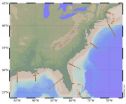(Press-News.org) A continental-scale chemical survey in the waters of the eastern U.S. and Gulf of Mexico is helping researchers determine how distinct bodies of water will resist changes in acidity. The study, which measures varying levels of carbon dioxide (CO2) and other forms of carbon in the ocean, was conducted by scientists from 11 institutions across the U.S. and was published in the journal Limnology and Oceanography.
"Before now, we haven't had a very clear picture of acidification status on the east coast of the U.S.," says Zhaohui 'Aleck' Wang, the study's lead author and a chemical oceanographer at Woods Hole Oceanographic Institution (WHOI). "It's important that we start to understand it, because increase in ocean acidity could deeply affect marine life along the coast and has important implications for people who rely on aquaculture and fisheries both commercially and recreationally."
Coastal ocean acidification, Wang says, can occur when excess carbon dioxide is absorbed by, flushed into or generated in coastal waters, setting off a chain of chemical reactions that lowers the water's pH, making it more acidic. The process disproportionately affects species like oysters, snails, pteropods, and coral, since those organisms cannot effectively form shells in a more acidic environment.
According to the survey, says Wang, different regions of coastal ocean will respond to an influx of CO2 in different ways. "If you put the same amount of CO2 into both the Gulf of Maine and the Gulf of Mexico right now, the ecosystem in the Gulf of Maine would probably feel the effects more dramatically," he says. "Acidity is already relatively high in that region, and the saturation of calcium carbonate—the mineral that many organisms need to make shells—is particularly low. It's not a great situation."
Excess CO2 can enter coastal waters from a variety of different sources, Wang says. One large source is carbon dioxide in the atmosphere, which has been steadily increasing in concentration worldwide for the past hundred and fifty years. The higher those levels of atmospheric CO2 rise, more CO2 gas will be absorbed into seawater by contact, says Wang. Another potential culprit, he notes, is nutrient-rich runoff from land. Rainfall and other surface flows can wash fertilizers and other byproducts of human activities into river systems and ground water, and ultimately, into the coastal ocean, delivering an excess of nutrients and often an explosion of biological activity that can lead to decreased oxygen and increased CO2 and acidity.
"This happens regularly in the Gulf of Mexico," says Wang. "The Mississippi River dumps enormous amounts of nitrogen and other nutrients into the Gulf, which spawns large algal blooms that lead to production of large amount of organic matter. In the process of decomposing the organic matter, the microbes consume oxygen in the water and leave carbon dioxide behind, making the water more acidic. If this process happens in the Gulf of Maine, the ecosystem there may be even more vulnerable since the Gulf of Maine is a semi-enclosed system and it may take longer time for low pH, low oxygen water to disperse."
Wang and his colleagues conducted their fieldwork in 2007 aboard the R/V Ronald H. Brown. Starting in the waters off Galveston, Texas, they worked their way around the Louisiana and west Florida coasts, past the Florida Straight, and up the eastern seaboard, collecting samples along nine different transects that ran from the coast to deep ocean off the shelf break, up to 480km (300 miles) offshore.
During the cruise, the researchers measured seawater samples for total dissolved inorganic carbon (DIC), which is made up of a combination of carbonate, bicarbonate, dissolved CO2 and carbonic acid. The team compared this measurement to the water's total alkalinity, a measure of how much base is in a water sample. The ratio of the two is a marker for water's ability to "buffer" or resist changes in acidity. Waters with a high ratio of alkalinity to DIC, Wang says, would be less susceptible to acidification than waters that showed a much lower ratio.
After analyzing their data, Wang and colleagues found that, despite a "dead zone" of low oxygen and high acidity outside the mouth of the Mississippi, the Gulf of Mexico on the whole showed a high ratio of alkalinity to DIC, meaning it would be more resistant to acidification. As the team traveled farther north, however, they saw the ratio steadily decreases north of Georgia. The waters in the Gulf of Maine, Wang says, on average had the lowest alkalinity to DIC ratio of any region along the eastern seaboard, meaning that it would be especially vulnerable to acidification should CO2 levels rise in those waters.
While it's unclear exactly why the ratio of alkalinity to DIC is low in those northern waters, Wang thinks part of the issue may be linked to alkalinity sources to the region. For example, the Labrador Coastal Current brings relatively fresh, low alkalinity water down from the Labrador Sea to the Gulf of Maine and Middle Atlantic Bight.
If this current is the major source of alkalinity to the region, he says, it may mean that the Gulf of Maine's fate could be linked to changes in global climate that, through melting sea ice and glaciers, increase the flow of fresh water to the Gulf of Maine. However, whether this freshening is accompanied by a decreases in seawater alkalinity and "buffer" capacity remains unknown.
Since the waters of the northeast U.S. are already susceptible to rising acidity, Wang says this raises big questions about how species of marine life—many of which are important to the commercial fishing and shellfish industry there—will fare in the future. "For example, how are oysters going to do? What about other shellfish? If the food chain changes, how are fish going to be impacted?" Wang asks. "There's a whole range of ecological and sociological questions." There is a great need for need for more robust coastal ocean chemistry monitoring and coastal ocean acidification studies, he adds. A better understanding of the changing chemistry will help fisheries regulators to better manage the stocks.
INFORMATION:
Also collaborating on the study were Rik Wanninkhof and Tsung-Hung Peng from the National Oceanic and Atmospheric Administration's Atlantic Oceanographic and Meteorological Laboratory, Wei-Jun Cai and Wei-Jen Huang of the University of Georgia, Robert H. Byrne of the University of South Florida, and Xinping Hu of Texas A&M University.
This research was supported by the NOAA Global Carbon Cycle Program.
The Woods Hole Oceanographic Institution is a private, non-profit organization on Cape Cod, Mass., dedicated to marine research, engineering, and higher education. Established in 1930 on a recommendation from the National Academy of Sciences, its primary mission is to understand the oceans and their interaction with the Earth as a whole, and to communicate a basic understanding of the oceans' role in the changing global environment. For more information, please visit www.whoi.edu.
New study reveals how sensitive US East Coast regions may be to ocean acidification
2013-03-01
ELSE PRESS RELEASES FROM THIS DATE:
Videocast on legal issues related to field trips and field courses released on YouTube
2013-03-01
Alexandria, VA – The American Geosciences Institute (AGI) and American Geophysical Union (AGU) have released a recording of the latest AGU/AGI Heads and Chairs webinar. This month's session focuses on legal issues related to field trips and field courses. The webinar, led by panelists David Mogk from Montana State University and Steven Whitmeyer from James Madison University, serves as a guide for reducing risk and liability for geoscience departments, and reviews tips for properly planning a safe and enjoyable field trip.
Although field work is acknowledged as an integral ...
Fish migrate to safer environments
2013-03-01
Research now reveals that fish can migrate to avoid the threat of being eaten. A new study from Lund University in Sweden shows that roach fish leave lakes and move into surrounding streams or wetlands, where they are safer from predators.
Every year, millions of animals migrate worldwide. In most cases, this is due to a shortage of food or other environmental factors. However, few research studies have focused on migration as a strategy to avoid predators. It is not easy to measure and quantify the risk of an animal being eaten.
"Our findings are therefore quite unique", ...
Scientists identify ancient micro-continent under the Indian Ocean
2013-03-01
Scientists at the Universities of Liverpool have found evidence of an ancient micro-continent buried beneath the Indian Ocean.
The ancient continent extends more than 1500 km in length from the Seychelles to the island of Mauritius and contains rocks as old as 2,000 million years, much older than the Indian Ocean which has formed only in the last 165 million years.
The research team believe that this micro-continent, which they have named Mauritia, was split off from Madagascar and India between 61 and 83 million years ago as one single land mass rifted apart to ...
Parkinson's disease: Parkin protects from neuronal cell death
2013-03-01
Researchers from Ludwig-Maximilians-Universitaet (LMU) in Munich identify a novel signal transduction pathway, which activates the parkin gene and prevents stress-induced neuronal cell death.
Parkinson's disease is the most common movement disorder and the second most common neurodegenerative disease after Alzheimer's disease. It is characterized by the loss of dopamin-producing neurons in the substantia nigra, a region in the midbrain, which is implicated in motor control. The typical clinical signs include resting tremor, muscle rigidity, slowness of movements, and ...
Living through a tornado does not shake optimism
2013-03-01
March 1, 2013 - Even in the face of a disaster, we remain optimistic about our chances of injury compared to others, according to a new study. Residents of a town struck by a tornado thought their risk of injury from a future tornado was lower than that of peers, both a month and a year after the destructive twister. Such optimism could undermine efforts toward emergency preparedness.
After an F-2 tornado struck his town in Iowa, Jerry Suls, a psychologist at the University of Iowa who studies social comparison, turned his attention to risk perception. "I had dinner as ...
CeBIT: IT for operation, care, and translation
2013-03-01
This press release is available in German.
The computer is increasingly used to help in complex situations. The latest innovations in this area will be presented by Karlsruhe Institute of Technology (KIT) and the FZI Research Center for Information Technology at the CeBIT in early March (hall 9, stand G33). User-friendly systems display all facts to surgeons during operation and simultaneously translate university lectures for foreign students. In addition, smart living environments that support comfort, safety, and care services and software for the relocation of ...
Big data: Searching in large amounts of data quickly and efficiently
2013-03-01
The term "big data" is defined as a huge amount of digital information, so big and so complex that normal database technology cannot process it. It is not only scientific institutes like the nuclear research center CERN that often store huge amounts of data ("Big Data"). Companies like Google and Facebook do this as well, and analyze it to make better strategic decisions for their business. How successful such an attempt can be was shown in a New York Times article published last year. It reported on the US-based company "Target" which, by analyzing the buying patterns ...
Volcanic aerosols, not pollutants, tamped down recent Earth warming, says CU-Boulder study
2013-03-01
A team led by the University of Colorado Boulder looking for clues about why Earth did not warm as much as scientists expected between 2000 and 2010 now thinks the culprits are hiding in plain sight -- dozens of volcanoes spewing sulfur dioxide.
The study results essentially exonerate Asia, including India and China, two countries that are estimated to have increased their industrial sulfur dioxide emissions by about 60 percent from 2000 to 2010 through coal burning, said lead study author Ryan Neely, who led the research as part of his CU-Boulder doctoral thesis. Small ...
Wild pollinators increase crop fruit set regardless of honey bees
2013-03-01
Changes made by humans to the natural landscapes can often compromise ecosystems, which paradoxically are vital for human survival. Pollination of crops by wild insects is one such vulnerable ecosystem service, as wild insects are declining in many agricultural landscapes. The study, recently published in Science, focused on understanding whether the ongoing loss of wild insects impacts crop harvest. For this purpose, the researchers compared fields with abundant and diverse wild insects to those with degraded assemblages of wild insects across 600 fields at 41 crop systems ...
Pregnancy permanently changes foot size
2013-03-01
A new University of Iowa study confirms what many women have long suspected – that pregnancy permanently changes the size and shape of a woman's feet.
Flat feet are a common problem for pregnant women. The arch of the foot flattens out, possibly due to the extra weight and increased looseness (laxity) of the joints associated with pregnancy. The new study, published in the March issue of the American Journal of Physical Medicine & Rehabilitation, suggests that this loss of arch height is permanent.
"I had heard women reporting changes in their shoe size with pregnancy, ...




